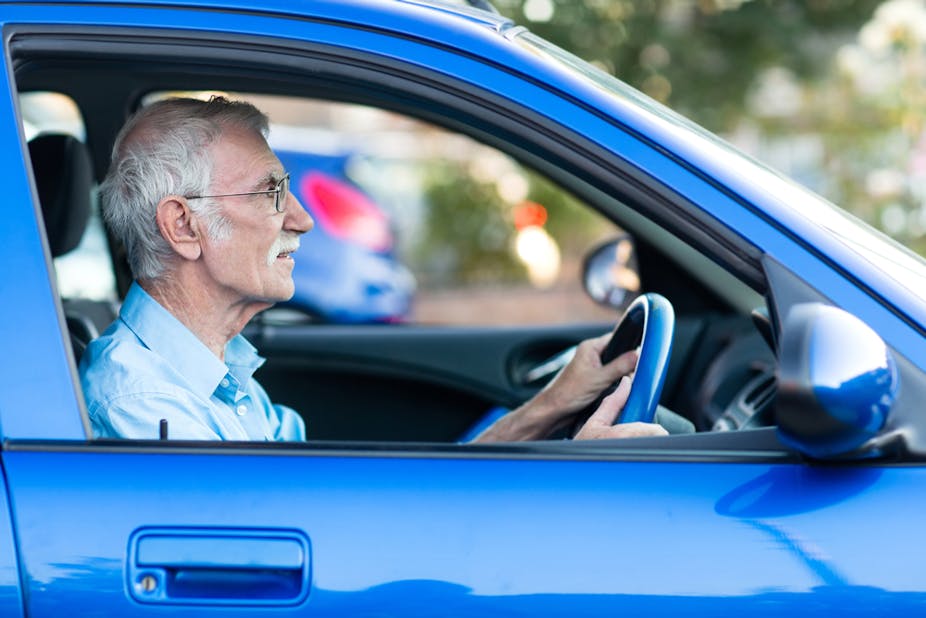When an older driver has a crash with tragic consequences, there are calls for stricter licensing controls to detect “unfit” drivers and take their licences away, typically focusing on those aged 75 or over. We saw this most recently when a heavily pregnant Queensland woman was killed in an accident last month at Brisbane’s Cleveland Showgrounds car park.
The argument for stricter controls over older drivers has some validity, because cognitive and physical ability decline with age. However, ageing takes place at different rates in different people, and in different ways. Recent research found that most older people showed little or no cognitive decline over a 20 year period, while those who did exhibited a rapid decline.
Furthermore, even the oldest age groups of drivers have lower crash rates than our youngest drivers.
Around the world there are many different licensing practices that apply to older drivers, many of them summarised in a report supporting a current public consultation process in Queensland. Some states in the United States begin to impose constraints on licensing for people as young as 40, while other jurisdictions (including Victoria) have no age-based restrictions and others (including Western Australia and Tasmania) are relaxing theirs.
When the crash records for older drivers are compared across jurisdictions, however, there is no observable impact of any restrictions. This includes compulsory re-testing, which is strongly advocated by the public but is not supported by the research.
To some extent, older drivers reduce their overall crash risk by driving less and by avoiding heavy traffic and night-time driving. The community encourages this type of self-regulation by older drivers, although the evidence for its effectiveness is unclear.
Some drivers are not aware of their limitations, and others are aware but unable to compensate or adapt effectively. There is also a reliance on medical practitioners to be aware of emerging or worsening medical conditions that affect their patients’ driving; this system seems to work, albeit imperfectly.

Focusing our attention on ways to take older drivers off the road is short-sighted, given the ageing of Australia’s population. In 1970, for every 100 Australians aged 15-24 (which captures our young drivers) there were 17 Australians aged 75 or more. By 2010 this had risen to 46, and by 2050 it will be 106.
Every successive cohort of older drivers is more likely to be licensed too; figures from Queensland show that in 1988, 39% of people aged 70 or more were licensed, and by 2008 it had risen to 61%.
This significant shift in the age of drivers will have consequences for patterns of crashes. Older drivers are more likely to be considered at fault for their crashes, as are young drivers, but the kinds of “fault” differ. Young drivers are more likely to be at fault because they engage in risky behaviours such as speeding and drink driving, which can be addressed with enforcement; older drivers are more likely to be at fault because they make an error of judgement, such as whether there is enough gap to make a safe turn, and enforcement is not an appropriate option.
Older drivers make errors because they are less able to deal with complexity and rapid decision-making. If the driving environment can be made less complex and demanding, older drivers can continue to drive safely for longer. This is a matter of degree rather than a quantum leap:
The demands of decision-making at intersections can be addressed by introducing more fully controlled turns (arrows) at traffic signals.
Standards for sight distance and signage can be changed to meet the needs of older drivers.
Lighting can be improved at key points (curves and intersections).
In-vehicle technologies can be further developed and implemented to assist older drivers. These include night vision systems and lane changing assistants.
Parking assistant systems and collision avoidance intervention systems (that will brake if the driver does not) are also important, especially in the context of the recent high-profile Queensland crashes, both of which occurred in parking areas.
There are also challenges in changing the driving environment that need to be met. Older drivers avoid freeways because merging at speed is a threatening situation, yet freeways are a safer driving environment than other roads; we need to find ways of assisting older drivers’ entry to and exit from freeways.
The behaviour of other drivers is especially important; if a driver is receiving too much input to process, the most immediate way to reduce the flow of information is to slow down. Unfortunately, most drivers regard maximum speed limits as mandatory minimum speeds, and many will attempt to pressure slower drivers to go faster. In practice, these marginal differences in speed have a negligible impact on travel time.
Given that mobility is a key element of quality of life for older people, with accompanying health implications, both health and transport authorities should focus on helping older drivers to drive safely for longer, not on taking them off the road.

